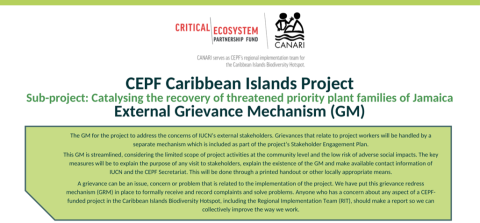

The following is the GM for the project to address the concerns of IUCN’s external stakeholders. Grievances that relate to project workers will be handled by a separate mechanism which is included as part of the project’s Stakeholder Engagement Plan.
This GM is streamlined, considering the limited scope of project activities at the community level and the low risk of adverse social impacts. The key measures will be to explain the purpose of any visit to stakeholders, explain the existence of the GM and make available contact information of IUCN and the CEPF Secretariat. This will be done through a printed handout or other locally appropriate means.
At the project level, all complaints should be received by the Human Resources Officer at IUCN North America Regional Office. Complaints can be made in person, in writing, verbally over the phone, by email or any other suitable medium. Complaints can be filed anonymously. The point of receipt of complaints is listed below:
Human Resources Officer at IUCN North America Regional Office
+1 (202)-984-7523
IUCN North America Regional Office, Washington D.C. Office, 1630 Connecticut Ave., NW, Suite 300, Washington, D.C. 20009, U.S.A
Acknowledgement:
All grievances will be acknowledged by telephone or in writing by the Human Resources Officer at IUCN North America Regional Office within 48 hours of receipt and the complainant will be informed of the approximate timeline for addressing the complaint, if it can’t be addressed immediately. The Human Resources Officer at IUCN North America Regional Office will seek to ensure the speedy resolution of the grievance. If the grievance cannot be resolved at this level, it is taken to the next level.
Record:
The grievance will be registered in IUCN’s grievance file, including relevant documents.
Notification:
Communication of the grievance as follows:
Assessment:
A decision is made on the nature of the investigation that will take place.
Investigation:
Appropriate investigation of the grievance by an internal team assigned to this task (for example, this may include staff directly involved as well as the Manager IUCN-CI Biodiversity Assessment Unit. The investigation may include meetings with the complainant and other stakeholders and a review of relevant documents. An impartial party shall be involved in meetings with the complainant. Community representatives or representatives of the complainant will be allowed to sit in on these meetings. Minutes of meetings and documents will be added to the grievance file.
Resolution:
Depending on the findings of the investigation:
Communication:
Once a resolution has been reached, the decision is communicated to the complainant in writing. Documents are added to the grievance file.
Satisfaction:
If the complainant is not satisfied by IUCN’s response, it can be taken to the second level of redress. At all stages, documents are added to the grievance file.
NB: The complainant may request that the issue be transferred to the second level of redress if he/she does not feel that the grievance is being adequately addressed by the Grant Director for the Caribbean Islands Biodiversity Hotspot.
If claimants are not satisfied with the way in which their grievance has been handled at level one, they will be given the opportunity to raise it directly with the Manager of the Regional Implementation Team (CANARI), who can be contacted as follows:
Manager of the Regional Implementation Team
+1-868-638-6062, +1-868-674-1558
executive.director@canari.org
#105 Twelfth Street, Barataria, Trinidad and Tobago
If claimants are not satisfied with the way in which their grievance has been handled at level one, they will be given the opportunity to raise it directly with the CEPF Grant Director for the Caribbean Islands Biodiversity Hotspot, who can be contacted as follows:
Grant Director for the Caribbean Islands Biodiversity Hotspot
+1-703-341-2400
cepf@cepf.net
Critical Ecosystem Partnership Fund, 2011 Crystal Drive, Suite 600, Arlington, VA 22202, USA
If claimants are not satisfied with the way in which their grievance has been handled at level three, they can contact the CEPF Executive Director via the CI Ethics Hotline (telephone: +1-866-294-8674 / web portal: https://secure.ethicspoint.com/domain/media/en/gui/10680/index.html).
If the complainant does not accept the solution offered by the CEPF Executive Director, then the complaint is passed on to the fourth level. Alternatively, the complainant can access the fourth level at any point. It is expected that the complaint will be resolved at this level within 35 working days of receipt of the original complaint. However, if both parties agree that meaningful progress towards resolution is being made, the matter may be retained at this level for a maximum of 60 working days.
CEPF Executive Director
+1-866-294-8673
https://secure.ethicspoint.com/domain/media/en/gui/10680/index.html